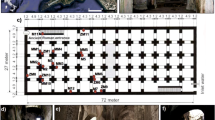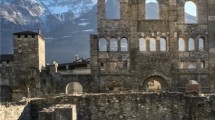Abstract
This paper shows the results of a multidisciplinary study carried out on the mortars from the Late Roman Villa dell’Oratorio (fourth-sixth ad), an aristocratic mansion built in the lower Valdarno (Florence, Italy). Thirty-one bedding mortar and plaster samples were analysed through optical microscopy, thermogravimetric analysis, X-ray powder diffraction and scanning electron microscopy with energy-dispersive X-ray spectroscopy for determining the chemical, mineralogical and petrographic characteristics, while their main physical properties were measured by geotechnical procedures. The collected data indicates that the analysed mortars are made up of very fine to coarse river sand aggregate mixed with white to yellowish-white natural hydraulic lime binder mainly consisting of mixtures of prevailing calcite and hydraulic compounds. With regard to the origin of the raw materials, the aggregates were recognized to be selected Arno river sands, and the binders are the burning product of a local marly limestone (ex Alberese). Therefore, the mortars of the Late Roman Villa dell’Oratorio are one of the first uses of natural hydraulic lime in the lower Valdarno.







Similar content being viewed by others
References
Alderighi L, Cantini F, Fatighenti B, Gallerini G, Mastrofrancesco A (2011) Capraia e Limite (FI) La villa dei Vetti: nuove e vecchie indagini archeologiche in una grande villa tardoantica del medio Valdarno. Notiziario della Soprintendenza per i Beni Archeologici della Toscana 6:47–81
Anderson E, Almond MJ, Matthews W (2014) Analysis of wall plasters and natural sediments from the Neolithic town of Çatalhöyük (Turkey) by a range of analytical techniques. Spectrochim Acta A 133:326–334
Antonelli F, Lazzarini L, Cancelliere S (2012) Minero-petrographic characterisation of the mortars and its possible application in the definition of the building phases. In: Tonghini C (ed) Shayzar I. The fortification of the citadel C. History of warfare, vol 71. Brill, Leiden-Boston, pp. 315–323
Antonelli F, Savalli A, Cantisani E, Fratini F, Giamello M, Lezzerini M, Pecchioni E, Tesser E (2016) Multianalytical approach to diagnosis and conservation of building materials: the case of Punta Troia Castle in Marettimo (Aegadian Islands—Sicily, Italy). Applied Physics A 122(4):1–10
Bakolas A, Biscontin G, Contardi V, Franceschi E, Moropoulou A, Palazzi D, Zendri E (1995) Thermoanalytical research on traditional mortars in Venice. Thermochim Acta 269–270:817–828
Bany Yaseen IA, Al-Amoush H, Al-Farajat M, Mayyas A (2013) Petrography and mineralogy of Roman mortars from buildings of the ancient city of Jerash, Jordan. Constr Build Mater 38:465–471
Belfiore CM, Fichera GV, La Russa MF, Pezzino A, Ruffolo SA, Galli G, Barca D (2015) A multidisciplinary approach for the archaeometric study of pozzolanic aggregate in roman mortars: the case of Villa dei Quintili (Rome, Italy). Archaeometry 57(2):269–296
Bertolini L, Carsana M, Gastaldi M, Lollini F, Redaelli E (2013) Binder characterisation of mortars used at different ages in the San Lorenzo Church in Milan. Mater Charact 80:9–20
Biscontin G, Pellizon Birelli M, Zendri E (2002) Characterization of binders employed in the manufacture of Venetian historical mortars. J Cult Herit 3:31–37
Blaeuer C, Kueng A (2007) Examples of microscopic analysis of historic mortars by means of polarising light microscopy of dispersions and thin sections. Mater Charact 58:1199–1207
Bortolotti V (1964) Nota illustrative alla carta della distribuzione geografica della Formazione di Monte Morello (Alberese). B Soc Geol Ital 83:155–190
Bruno P, Calabrese D, Di Pierro M, Genga A, Laganara C, Manigrassi DAP, Traini A, Ubbrìaco P (2004) Chemical–physical and mineralogical investigation on ancient mortars from the archaeological site of Monte Sannace (Bari-Southern Italy). Thermochim Acta 418:131–141
Cardoso I, Macedo MF, Vermeulen F, Corsi C, Santos Silva A, Rosado L, Candeias A, Mirao J (2014) A multidisciplinary approach to the study of archaeological mortars from the town of Ammaia in the Roman Province of Lusitania (Portugal). Archaeometry 56(1):1–24
Cavalieri M, Baldini G (2005) San Gimignano (SI): la villa romana di Torraccia di Chiusi. Notiziario della Soprintendenza per i Beni Archeologici della Toscana 1:401–409
Corti C, Rampazzi L, Bugini R, Sansonetti A, Biraghi M, Castelletti L, Nobile I, Orsenigo C (2013) Thermal analysis and archaeological chronology: the ancient mortars of the site of Baradello (Como, Italy). Thermochim Acta 572:71–84
De Luca R, Miriello D, Pecci A, Domínguez-Bella S, Bernal-Casasola D, Cottica D, Bloise A, Crisci GM (2015) Archaeometric study of mortars from the Garum shop at Pompeii, Campania, Italy. Geoarchaeology 30(4):330–351
Elsen J (2006) Microscopy of historic mortars—a review. Cement Concrete Res 36:1416–1424
Elsen J, Brutsaert A, Deckers M, Brulet R (2004) Microscopical study of ancient mortars from Tournai (Belgium). Mater Charact 53:289–294
Fichera GV, Belfiore CM, La Russa MF, Ruffolo SA, Barca D, Frontoni R, Galli G, Pezzino A (2015) Limestone provenance in Roman lime-volcanic ash mortars from the Villa dei Quintili, Rome. Geoarchaeology 30(2):79–99
Fracchia H (2006) The villa at Ossaia and the territory of Cortona in the Roman period. Bonanno Editore, Padova
Franzini M, Lezzerini M (1998) Le pietre dell’edilizia medievale pisana e lucchese (Toscana occidentale). 2 I calcari selciferi del Monte Pisano. Atti Soc Tosc Sci Nat Mem Serie A 105:1–8
Franzini M, Lezzerini M (2003a) A mercury-displacement method for stone bulk-density determinations. Eur J Mineral 15:225–229
Franzini M, Lezzerini M (2003b) The stones of medieval buildings in Pisa and Lucca provinces (western Tuscany, Italy). 1—the Monte Pisano marble. Eur J Mineral 15:217–224
Franzini M, Leoni L, Lezzerini M (2000a) A procedure for determining the chemical composition of binder and aggregate in ancient mortars: its application to mortars from some medieval buildings in Pisa. J Cult Herit 1:365–373
Franzini M, Leoni L, Lezzerini M, Sartori F (2000b) The mortar of the “Leaning Tower” of Pisa: the product of a medieval technique for preparing high-strength mortars. Eur J Mineral 12:1151–1163
Fratini F, Giovannini P, Manganelli del Fa’ C. (1994) La Pietra da calce a Firenze: ricerca e caratterizzazione dei materiali per la produzione di ‘calcina forte’ e ‘calcina dolce’. Atti del Convegno di Studi “Scienza e Beni Culturali n° 10: Bilanci e Prospettive”, Bressanone 5–8 Luglio 1994, Ed. Libreria Progetto, Padova, 189–199
Genestar C, Pons C, Más A (2006) Analytical characterisation of ancient mortars from the archaeological Roman city of Pollentia (Balearic Islands, Spain). Anal Chim Acta 557:373–379
Gotti E, Oleson JP, Bottalico L, Brandon C, Cucitore R, Hohlfelder RL (2008) A comparison of the chemical and engineering characteristics of ancient roman hydraulic concrete with a modern reproduction of Vitruvian hydraulic concrete. Archaeometry 50(4):576–590
Head KH (1994) Manual of soil laboratory testing. Volume 2: permeability, shear strength and compressibility tests, 2nd edn. Wiley, New York
Ingo GM, Fragalà I, Bultrini G, De Caro T, Riccucci C, Chiozzini G (2004) Thermal and microchemical investigation of Phoenician–Punic mortars used for lining cisterns at Tharros (western Sardinia, Italy). Thermochim Acta 418:53–60
Jackson MD, Deocampo D, Marra F, Scheetz B (2010) Mid-Pleistocene pozzolanic volcanic ash in ancient Roman concretes. Geoarchaeology 25(1):36–74
Jackson MD, Rosseto PC, Kosso CK, Buonfiglio M, Marra F (2011) Building materials of the theatre of Marcellus, Rome. Archaeometry 53(4):728–742
Karkanas P (2007) Identification of lime plaster in prehistory using petrographic methods: a review and reconsideration of the data on the basis of experimental and case studies. Geoarchaeology: An International Journal 22(7):775–796
Leoni L, Lezzerini M, Battaglia S, Cavalcante F (2010) Corrensite and chlorite-rich Chl-S mixed layers in sandstones from the ‘Macigno’ formation (northwestern Tuscany, Italy). Clay Miner 45:87–106
Lezzerini M, Legnaioli S, Lorenzetti G, Palleschi V, Tamponi M (2014) Characterization of historical mortars from the bell tower of St Nicholas church (Pisa, Italy). Constr Build Mater 69:203–212
Marinoni N, Pavese A, Foi M, Trombino L (2005) Characterization of mortar morphology in thin sections by digital image processing. Cem Concrete Res 35:1613–1619
Merla G, Bortolotti V, Passerini P (1967) Note illustrative alla Carta Geologica alla scala 1:100000, Foglio 106, Firenze. Servizio Geologico d’Italia, Roma
Mertens G, Elsen J, Brulet R, Brutsaert A, Deckers M (2009) Quantitative composition of ancient mortars from the Notre Dame Cathedral in Tournai (Belgium). Mater Character 60:580–585
Miriello D, Lezzerini M, Chiaravalloti F, Bloise A, Apollaro C, Crisci GM (2013) Replicating the chemical composition of the binder for restoration of historic mortars as an optimization problem. Comput Concrete 12:553–563
Miriello D, Antonelli F, Apollaro C, Bloise A, Bruno N, Catalano M, Columbu S, Crisci GM, De Luca R, Lezzerini M, Mancuso S, La Marca A (2015) A petro-chemical study of ancient mortars from the archaeological site of Kyme (Turkey). Per Miner 84(3A):497–517
Moropoulou A, Bakolas A, Bisbikou K (1995) Characterization of ancient, byzantine and later historic mortars by thermal and X-ray diffraction techniques. Thermochim Acta 269–270:779–795
Moropoulou A, Bakolas A, Bisbikou K (2000) Investigation of the technology of historic mortars. J Cult Herit 1:45–58
Morricone A, Macchia A, Campanella L, David M, De Togni S, Turci M, Maras A, Meucci C, Ronca S (2013) Archaeometrical analysis for the characterization of mortars from Ostia Antica. Procedia Chemistry 8:231–238
Pavia S, Caro S (2008) An investigation of roman mortar technology through the petrographic analysis of archaeological material. Constr Build Mater 22:1807–1811
Pecchioni E, Fratini F, Cantisani E (2006) The ancient mortars, an attestation of the material culture: the case of Florence. Per Mineral 75(2–3):255–262
Sánchez-Moral S, Luque L, Cañaveras JC, Soler V, Garcia-Guinea J, Aparicio A (2005) Lime pozzolana mortars in Roman catacombs: composition, structures and restoration. Cem Concr Res 35:1555–1565
Taylor HFW (1972) The chemistry of cements. Volumes 1 and 2. Academic, London
Tucker ME (1981) Sedimentary petrology. Blackwells Publishing, Oxford
UNI 11060 (2003) Beni culturali—Materiali lapidei naturali ed artificiali—Determinazione della massa volumica e della percentuale di vuoti. UNI—Ente Nazionale Italiano di Unificazione, Milano
Vendrell-Saz M, Alarcón S, Molera J, Garcia-Vallés M (1996) Dating ancient lime mortars by geochemical and mineralogical analysis. Archaeometry 38(1):143–149
Acknowledgments
The sampling was carried out under permission of the Soprintendenza Archeologia Belle Arti e Paesaggio (SABAP) di Firenze, Prato e Pistoia. The authors are grateful to Marcello Spampinato for his support and assistance in the mortar sampling and in the preparation of the specimens for optical microscope observation. The authors would like to thank the two anonymous reviewers for their helpful comments.
Author information
Authors and Affiliations
Corresponding author
Rights and permissions
About this article
Cite this article
Lezzerini, M., Ramacciotti, M., Cantini, F. et al. Archaeometric study of natural hydraulic mortars: the case of the Late Roman Villa dell’Oratorio (Florence, Italy). Archaeol Anthropol Sci 9, 603–615 (2017). https://doi.org/10.1007/s12520-016-0404-2
Received:
Accepted:
Published:
Issue Date:
DOI: https://doi.org/10.1007/s12520-016-0404-2




